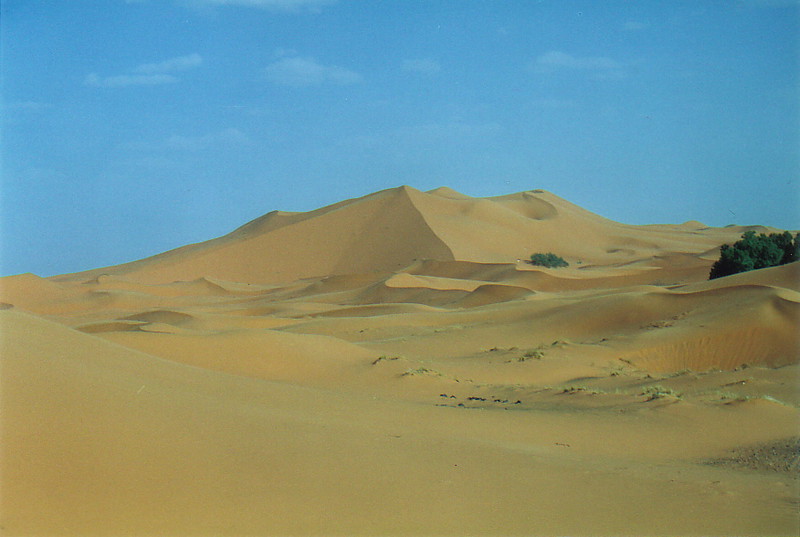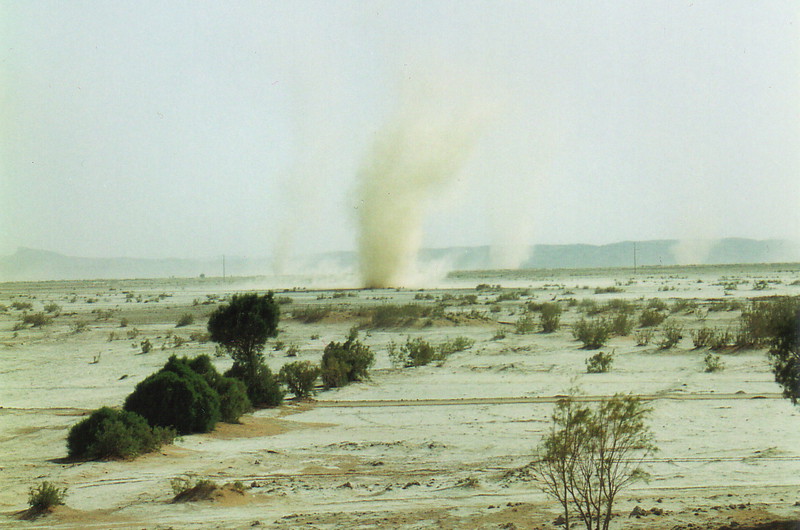
While lazing away the hours in Rissani, I'd been investigating the route to Merzouga, the home to the only genuine Saharan ergs in Morocco (an erg being a classic, sand dune desert). There are two roads to Merzouga, but both are relatively scary. The route from Rissani is the shorter of the two, but sections of it are pretty rough, and in a rented Fiat Uno it's probably not in your interests to try it, unless being stranded in the middle of the desert is your cup of tea. The other route, from Erfoud, is easier to follow, but it's still along rough dirt roads (or pistes as they're known in Morocco) and the guidebooks are careful to sound a note of caution, while still saying that normal cars can reach Merzouga without serious problems.

Not wishing to get stuck with a stranded car in the desert, Peta and I had popped into Rissani to check out the score, only to be welcomed by the usual gaggle of young men trying desperately to sell us their guiding skills and goodness knows what else. They felt about as trustworthy as the most dodgy Moroccans do – in other words, you'd trust them as far as you can spit, which in the desiccated desert is no distance at all – so we turned around and decided to risk driving to Erfoud and them down to Merzouga.
It proved to be no scarier than the corrugated dirt roads in outback Australia, and we made it to Merzouga without any lasting damage (though the bone-shaking roads made it sound as if the car, now nicknamed Sandy, was about to fall apart in spectacular style). Things were helped by a couple of tourists we'd brought along from the hotel, Mike and Marie, who would have been very handy if we'd got stuck in sand, and provided us with enough confidence to tackle the desert and win.

The drive itself was beautiful, and after about 40 minutes of rattling and swerving round the potholes, the sand dunes of Erg Chebbi popped into view on the horizon, like a huge red mountain range in the distance. We bumped our way along the dusty dirt road straight towards the dunes, and as they got closer the red dissolved into a myriad mix of peach, ochre and brown, giving the dunes a magical look that made all the bouncing worthwhile.
Sure, we got stuck in the sand when we got to Merzouga itself, but who cares? It was the work of two minutes to push us back onto the road, and it wasn't long before we'd found a genuine oasis at the end of the caravan route: the Ksar Sania has atmospheric double rooms set in their own desert cottages (complete with roof), and suddenly life never seemed better. The peach dunes rose from the desert a stone's throw from our roof terrace, camels wandered around, mini-dust storms blew through town, and the peace was complete.
How I love the desert, especially when you can get a nice, cold bottle of water to keep the heat in check...
Exploring the Saharan Dunes
There isn't a lot of water in the Sahara, and the sign in the hotel made the point pretty succinctly:
Ksar Sania
Water is very precious.
Water is necessary for life.
The desert has a serious lack of it.
It hasn't rained since 1995.
Do not waste it.
Help us to conserve it.
Françoise and Gérard

It's obvious just how dry it is in the desert from the speed at which your clothes dry after washing: lie your soaking towel on the roof and the scorching winds will dry it in under 15 minutes, not surprising then you consider the maximum temperature when we were in Merzouga was a whopping 48°C (and the minimum was 27°C, a respectable temperature for a midsummer's day in England).
Your lips dry up unless you constantly apply lip salve, your skin starts to flake, and the flies will land on absolutely anything that contains even a hint of water, including tear ducts, the corners of your mouth, and any portion of visible, sweating skin. It is hot beyond words.

But that's the point, and it would be a pretty stupid thing to complain about the heat when you've just crossed hours of stony desert to check out the Sahara in June. If you wanted to explore the desert in a more amenable climate, then although Merzouga hasn't had any rain since 1995, it's not devoid of water. Indeed, when it rains in the High Atlas, and when the snow melts, the rivers rage, creating havoc for local transport but feeding the oases with enough water to sustain life. Merzouga even boasts a lake for part of the year, and it glimmers on the horizon, attracting flamingos into the otherwise utterly inhospitable environment of the desert. As you drive along the roads of the hammada the most common road sign is the one warning of a ford in the road, sporting a car plunging through water, spraying out from under its wheels. It's an odd thought as you rattle over river-beds that look like they've never seen water, let along flooding.

But without this amazing lack of rainfall you wouldn't have the dunes, and it's the dunes that make the Sahara. Stony desert is one thing, but after a while the beauty of the hammada begins to pale, which is why it's such an epiphany driving to Merzouga and seeing the huge dunes of the Erg Chebbi rising up on the horizon. Located right next to the town of Merzouga, the dunes rise up 150m in huge piles of peach undulation, and if, like me, you're unable to pass a mountain without wanting to climb it, you're in for a treat.
Climbing sand dunes is an art, and it's one I don't particularly understand. Dunes are no more than huge piles of sand – indeed, in the Erg Chebbi you can see the underlying ground, and it genuinely looks like someone has simply dumped a load of peach-coloured sand straight onto the ground – but climbing huge piles of sand is no joke, especially in the baking Saharan sand. If you try to traverse the dunes, you'll slip downhill; if you try to climb straight up, then it's two steps up, one step down; if you climb in boots then they'll fill with heavy sand within two minutes, but if you climb in sandals your feet will fry; your water will be as hot as tea within half an hour of setting off; and when the wind blows, as it does an awful lot in the desert, your molars fill up with sand and your eyes feel like sand pits.

Get up that dune, though, and who cares about the hurt? The landscape is like no other, because Erg Chebbi is nothing other than a peach sand mountain range. OK, so the mountains aren't huge, but the range of textures and colours is so other-worldly that it's trivial to trick yourself into thinking that you're staring at a massive Martian landscape of rifts, valleys and dizzying heights. The dunes don't go on as far as the eye can see – they're bound on all sides by hammada – but they do extend for a number of kilometres in each direction, and it's easy to kid yourself that you're surrounded by sand right to the horizon and beyond.
Which is one of the points of the Sahara, I think.